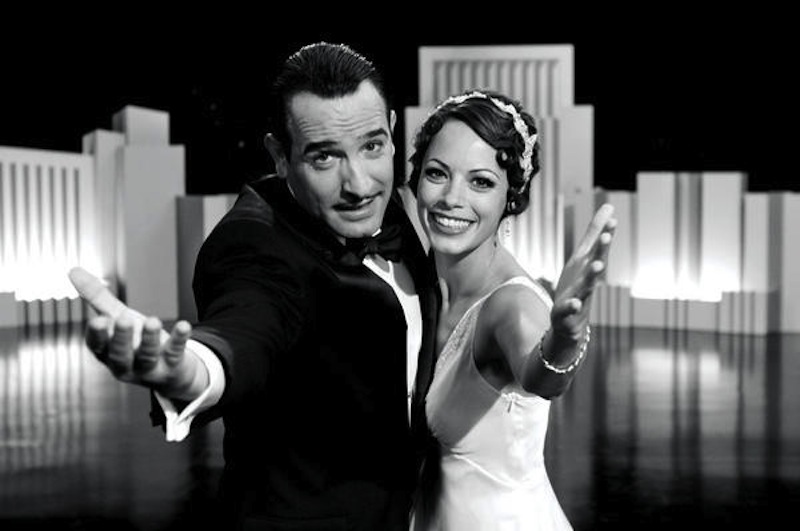As Dana Baldwin settled into her theater seat and watched the opening sequence of “The Artist” crackle across the screen, she couldn’t help but think of her grandmother.
As a young woman, Baldwin’s grandmother played the piano at the silent-movie house in Chillicothe, Ohio. “The Artist” opens with a movie within a movie that includes a scene of an orchestra playing along with a silent film.
But as the movie rolled, Baldwin, a film buff who directs the education department at the Portland Museum of Art, quickly found herself engrossed in its story. “The Artist” brought back memories of her family, yet it didn’t feel nostalgic.
“I just thought it was a beautiful movie, and it felt so original,” she said.
With the Academy Awards at hand, everybody is talking about “The Artist.” The mostly silent black-and-white phenomenon is considered a front-runner to win best picture honors tonight.
The movie has wooed fans and critics alike with its charm, grace, sensitivity and gorgeous cinematography. It is on one level a throwback to a long-ago era of film, but it also feels very modern and sophisticated in its approach and message.
It’s the season’s surprise hit, garnering 10 Oscar nominations, the top prize at the Producers Guild Awards and a Golden Globe. Lead actor Jean Dujardin also has won top awards for his acting performance, and is up for a best actor Oscar tonight.
“The Artist” tells the story of George Valentin, a star of the silent-film circuit played brilliantly by Dujardin. He struggles to find his place in the world with the advent of talking movies, especially when his star is eclipsed by the young darling of the new technology, Peppy Miller (Berenice Bejo).
Set in the late 1920s in Los Angeles, “The Artist” has captured the imagination of many because it’s a black-and-white tribute to the film industry’s early years. It is not an entirely silent movie, but sound and dialogue are minimal. The movie relies on the imagination and mental engagement of the viewer.
Amanda Houtari, executive director of Celebration Barn Theater in South Paris — which has trained artists, actors, dancers, mimes, jugglers and storytellers for two generations — appreciated “The Artist” on several levels. She loved director Michel Hazanavicius’ movie-making techniques, particularly his decision to tell the story in silence and without color.
But she most appreciated the story itself. To her, the film succeeded not because of its old-school storytelling method, but because of the screenplay.
“I just really appreciated seeing George as an artist and the challenges he faced in accepting and finding a role for himself in an ever-evolving world,” said Houtari. “I see George in the context of the risks of any artist defining themselves in any project they have already created, and the fear we all face of not finding a way to continue growing and evolving creatively.”
Steve Halpert, film curator at the Portland Museum of Art, has programmed earlier Hazanavicius movies to be shown as part of the PMA’s Movies at the Museum series. In May, the museum will show a pair of James Bond spoofs that the French director made a few years ago. He assumes the success of “The Artist” will spawn interest in Hazanavicius’ other films.
“People are just charmed by it. They like it a lot,” said Halpert. “It’s just a very well-made movie.”
As popular as “The Artist” is, Halpert does not expect that it will change the way films are made. It may expand viewers’ appreciation of silent movies and inspire some to seek out older silent films. “But it’s only one film. It certainly isn’t going to displace sound movies,” he said.
Davis Robinson teaches at the Barn, and is a theater professor at Bowdoin College in Brunswick. He was a college student in western Massachusetts during a previous silent-film revival in the 1960s and ’70s, and was able to watch many Buster Keaton and Charlie Chaplin films on the big screen. Today, one has to watch those movies on DVD or find a specialty theater in a big city.
If “The Artist” inspires another silent-film revival and gives movie fans the opportunity to learn about classic silent films, that will become its legacy, he said.
“Maybe it will pique people’s interest. Those days are an inspiration, and there is a link to contemporary culture that is still vibrant, that is exciting, without being a nostalgia fest,” said Robinson, who wrote “The Physical Comedy Handbook” and is one of Maine’s leading authorities on acting.
Robinson was most impressed with the performances of Dujardin and Bejo.
“You just have to be a really good actor to pull that off,” he said. “They really told a story, and yet there is some real human quality underneath it all.
“I just thought it was a beautiful movie.”
Staff Writer Bob Keyes can be contacted at 791-6457 or at:
bkeyes@pressherald.com
Twitter: pphbkeyes
Send questions/comments to the editors.



